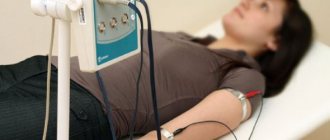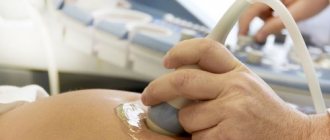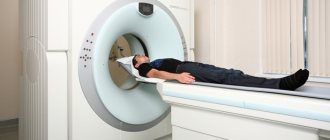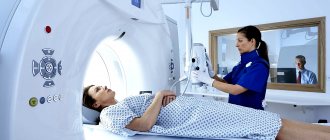Carrying out capillaroscopy: indications, methodology and results
Capillaroscopy of the nail bed is an informative and non-invasive (without penetration) method for assessing the condition of the human circulatory system.
At the same time, thanks to the use of a special device, it is possible to determine the shape of the capillaries, their length and deformation. As a rule, this type of study is suitable for assessing the state of the microvasculature in hypertension, heart failure, diabetes, etc.
Before performing capillaroscopy, you should consult your doctor about the indications for the method, as well as possible refusal of the procedure if it is irrational.
The most convenient place for capillaroscopy is the skin of the fingers in the area of the nail fold.
general description
Capillaroscopy allows you to assess the state of the microvasculature in a living person, without any restrictions on age or concomitant diseases.
Most often, capillaries of the nail bed are used for this method, which is due to their horizontal location and superficial localization.
This greatly simplifies the entire procedure and allows it to be carried out in a short period of time without special preparation of the patient for the study.
To examine capillaries, a capillaroscope is used - a small optical device that combines an optical system and a finger clamp. There are varieties of devices with the ability to photograph the resulting image.
Conducting research
It is very important to do the research correctly. To do this, the attending physician initially talks about the procedure.
1-3 minutes before it is carried out on the skin in the area of the nail fold (usually the ring finger of the hand is used), it is necessary to apply a few drops of glycerin or some vegetable oil. Thanks to this, an increase in the homogeneity of the epidermis is achieved, which improves the visibility of the capillaries.
After this, the finger is placed on a fixing stand and the lens of the device is brought to the area under study. Visible capillaries are sketched on paper or photographed using a special photo attachment.
The study is carried out in a medical institution by an attending physician who has undergone preliminary training.
There are special projection-drawing devices that allow you to obtain a more objective image of the capillary pattern. However, they are quite rare.
Normal capillaries are bright red in color, their arrangement is in the form of straight lines in several rows.
The shape of the pattern depends on the location of the capillaroscope lens and, most often, is presented in the form of hairpins, commas or a straight line. The average number of capillaries per millimeter is 8-10 pieces.
When using the method by an experienced doctor, the latter can even record the flow of blood through the capillaries.
Application of capillaroscopy
The use of this diagnostic method is possible in the following situations:
- Diagnostic procedures aimed at identifying the degree of damage to the microvasculature in cardiovascular, endocrine, rheumatological and other diseases.
- Capillaroscopy allows you to evaluate the effectiveness of drug therapy, as well as prevent the development of toxic effects from the use of drugs.
- Monitoring the microvasculature during surgery makes it possible to prevent the development of a number of complications associated with a drop in blood pressure, excessive activation of the sympathetic nervous system, etc.
Capillaroscopy has serious advantages that make this method widely recommended.
Medical device for monitoring the condition of capillaries
The use of capillaroscopy in these situations can improve the efficiency of diagnostic and therapeutic procedures. However, this diagnostic method is rarely used alone, but is more often combined with other diagnostic procedures.
Benefits of capillaroscopy
The widespread use of this research method is due to its advantages:
- There is no need for punctures or any other invasive interventions.
- High quality of information received about the state of the microvasculature.
- Availability of developed software systems that allow automating the assessment of results.
- Ease of use. Doctors do not need additional training to operate the device.
However, there are also disadvantages. One of the most significant is the non-acceptance of this method by some attending physicians.
Evaluation of results
When assessing the results of capillaroscopy, attention is paid to three main parameters: the shape of the capillaries, the nature of the blood movement through them and the area around the vessels. Changes in these characteristics may indicate existing or developing diseases.
It is recommended to save the obtained results for comparison with more recent data in the future.
Possible capillaroscopy pictures
The method is of greatest value in the diagnosis of diseases associated with impaired blood flow through vessels, such as Raynaud's disease, Takayasu's disease, obliterating endarteritis, atherosclerotic lesions, etc.
In these cases, an increase in the number of capillaries, their narrowing and deformation is clearly visible. However, as the disease progresses, the number of capillaries drops significantly and necrotic changes occur, associated with a significant decrease in blood flow.
If a patient has hypertension, the capillary pattern becomes tortuous, the area around the capillaries is unclear with signs of thickening of their walls. A similar picture can be observed in endocrine pathologies (diabetes mellitus, etc.).
The use of capillaroscopy allows you to easily and quickly diagnose diseases of the cardiovascular and other body systems without using any invasive procedures. In this regard, the method is widely used in clinical practice. However, before using it, you should consult with your doctor about the advisability of the procedure.
Source: //diagnostinfo.ru/skopiya/vidy/kapillyaroskopiya.html
Application of capillaroscopy
The use of this diagnostic method is possible in the following situations:
- Diagnostic procedures aimed at identifying the degree of damage to the microvasculature in cardiovascular, endocrine, rheumatological and other diseases.
- Capillaroscopy allows you to evaluate the effectiveness of drug therapy, as well as prevent the development of toxic effects from the use of drugs.
- Monitoring the microvasculature during surgery makes it possible to prevent the development of a number of complications associated with a drop in blood pressure, excessive activation of the sympathetic nervous system, etc.
Capillaroscopy has serious advantages that make this method widely recommended.
Medical device for monitoring the condition of capillaries
The use of capillaroscopy in these situations can improve the efficiency of diagnostic and therapeutic procedures. However, this diagnostic method is rarely used alone, but is more often combined with other diagnostic procedures.
Capillaroscopy, indications, performance, interpretation of results
The capillary network is the intercourse of several groups of tiny vessels of venous and arterial origin. Envelops the entire human body, supplying organs and tissues with important elements. It is extremely difficult to see healthy capillaries with the naked eye, but despite their small growth, the primary pathological changes in the circulatory system occur precisely in the microvasculature.
What is capillaroscopy
To study the morphological and functional characteristics of blood vessels, a minimally invasive and painless method is used - capillaroscopy.
The study is carried out under microscopic magnification with a specialized device - a capillaroscope.
The purpose of the study is to identify possible disturbances in the microvasculature and establish the cause of the disease.
Having undergone modifications, the device is able to convert the obtained data into graphs, diagrams, and also provide a clear image of the capillary pattern.
The non-invasive method is not a basis for confirming the diagnosis, but is widely used for primary disorders of the hemostatic system, complementing the clinical picture of the disease.
The scope of application of the capillaroscope is different. It depends on the location of the pathological process, but most often the nail area is examined due to the close proximity of blood vessels.
Symptoms of blood microcirculation disorders
External signs of a possible violation in the ICR include:
- deterioration of health;
- soreness and numbness of the fingertips;
- change in heart rate;
- fast fatiguability;
- sleep disturbance.
In addition, scientists have found that a patient suffering from microcirculatory insufficiency ages faster.
Internal symptoms of pathology include an increase in size, a change in color and slight swelling of the surrounding tissues.
Due to the fact that the capillaries experience a pathological effect in the absence of treatment, body activity is disrupted.
The process is quite lengthy only because the vessels are able to “switch off” from the circulatory system.
Application
Capillaroscopy allows:
- set the blood flow speed;
- determine the pressure and density of the vascular wall;
- detect disturbances in the functioning of the cardiovascular system;
- determine swelling of surrounding tissues;
- establish the causes of specific symptoms.
Capillaroscopy is performed on adults and children with congenital and acquired anomalies of the structure of the circulatory system. It can be used to determine the percentage of blood supply to the brain and heart muscle.
Conducting a microscopic examination of capillaries is necessary:
- persons suffering from diabetes;
- hypertensive patients;
- with existing ischemia of the heart or brain;
- patients with renal failure.
Benefits of the study:
- Painless – the method does not involve a puncture, since the examination is carried out through the skin.
- Diagnostic accuracy.
- Absolute safety during capillaroscopy.
- The procedure does not take more than 5 minutes.
- Cost, despite the fact that the diagnostic procedure is carried out at the patient’s personal expense, other diagnostic methods (CT, ultrasound and MRI) are much higher.
- Uniqueness and guarantee of the obtained data.
The procedure is different in that it prevents the development of diseases of the circulatory system, evaluates the effectiveness of the therapy and identifies the therapeutic result after the necessary treatment.
Manifestation of which diseases are determined using capillaroscopy
Using computer capillaroscopy, it is possible to identify suspected diseases in the initial stages, as well as assess the tendency to develop one or another type of pathology.
Morphological changes in the vascular wall and impaired blood supply indicate diseases such as:
- angina pectoris;
- diabetes in the early stages;
- myocardial infarction;
- congenital and acquired anomalies;
- endarteritis;
- atherosclerosis of peripheral vessels;
- thrombosis of the main veins and arteries;
- phlebeurysm;
- tendency to aggregation (thrombosis);
- Raynaud's disease.
Technique
The manipulation is carried out in public clinics, hospitals at the department of vascular surgery and private healthcare institutions. The manipulation is carried out as follows:
- the ring finger of the left hand is placed in the device's stock;
- the skin is lubricated with Vaseline or glycerin oil to obtain a better image;
- turn on the side light, and after 2 minutes the capillaroscope lens is directed to the surface being examined;
- Using projection, images of small vessels appear on a computer.
The procedure does not take much time and lasts about 6 minutes. During this time, the computer not only gives a picture of the vascular network and builds a graph of morphological features.
results
The results obtained are processed by specialists, and a conclusion is issued on the state of the microvasculature.
Normally, capillaries have a convoluted structure of a red hue. Throughout the entire lumen, the amount of blood flowing unhindered is revealed.
Externally, the vessel is compared to a lady's hairpin.
A cloudy background, overly curved lines, a change in color and a decrease in number indicate internal pathology.
Often, doctors discover a microscopic blockage of the canal, which results in a disruption of the blood supply.
Only a specialist can establish a presumptive diagnosis by comparing:
- clinical manifestations;
- morphological features;
- difficulty in blood flow;
- presence of swelling;
- change in quantity downwards.
Source: //venaprof.ru/kapillyaroskopiya/
What is capillaroscopy
To study the morphological and functional characteristics of blood vessels, a minimally invasive and painless method is used - capillaroscopy.
The study is carried out under microscopic magnification with a specialized device - a capillaroscope.
The purpose of the study is to identify possible disturbances in the microvasculature and establish the cause of the disease.
Having undergone modifications, the device is able to convert the obtained data into graphs, diagrams, and also provide a clear image of the capillary pattern.
The non-invasive method is not a basis for confirming the diagnosis, but is widely used for primary disorders of the hemostatic system, complementing the clinical picture of the disease.
The scope of application of the capillaroscope is different. It depends on the location of the pathological process, but most often the nail area is examined due to the close proximity of blood vessels.
Symptoms of blood microcirculation disorders
External signs of a possible violation in the ICR include:
- deterioration of health;
- soreness and numbness of the fingertips;
- change in heart rate;
- fast fatiguability;
- sleep disturbance.
In addition, scientists have found that a patient suffering from microcirculatory insufficiency ages faster.
Internal symptoms of pathology include an increase in size, a change in color and slight swelling of the surrounding tissues.
Due to the fact that the capillaries experience a pathological effect in the absence of treatment, body activity is disrupted.
The process is quite lengthy only because the vessels are able to “switch off” from the circulatory system.
Diagnosis of the body using a capillaroscope. Microcirculation. Microvessels. Capillaroscope
A unique opportunity to diagnose the body using a capillaroscope.
Or why do we need to look at our microvessels?
CAPILLAROSCOPY is a unique technique that has no analogues in the world, which reveals the state of microcirculation in the vessels. The capillary network represents
| Capillaries of a healthy person |
is the most important part of the human circulatory system.
Microcirculation in it delivers necessary substances, oxygen, hormones and biologically active structures to tissue cells, which remove decay products.
The state of normal patency or functioning of the capillaries is directly related to many factors, including the level of venous outflow, the state of the pericapillary sphincters, and the pressure in the arteriole.
Non-invasive (non-invasive) diagnostics is considered one of the priority areas of medical research throughout the world. When talking about it, the words “bloodless”, “painless”, “harmless” are often used.
Capillaroscopy makes it possible to diagnose many diseases (or predispositions to diseases)
| Lipid inclusions in a healthy person |
The cause of any disease is pathology of the capillaries
The onset of any vascular pathology, the development of which in most cases can be easily prevented with the help of modern medical technologies, is associated with circulatory disorders in the smallest blood vessels - capillaries.
Although the length of one such vessel is no more than 1 mm, the total length of all capillaries reaches 100,000 km. Figuratively speaking, each capillary is a microheart with two halves: arterial and venous.
10 trillion tiny arteries and veins daily and tirelessly provide the flow of nutrient-rich blood to the body's tissues and cells and regulate the outflow of harmful metabolic products. In almost all organs and tissues of the body, these microvessels form blood networks.
As soon as the capillaries stop
| Capillaries of a diabetic patient |
blood circulation, necrotic changes occur in the tissues - they die. That is why these microvessels are the most important part of the bloodstream.
Most modern diagnostic methods for studying blood vessels (angiography, Doppler ultrasound) make it possible to determine the state of blood circulation only in medium and large main vessels, changes in which indicate that the disease has already entered the stage at which it is too late to talk about prevention.
Impaired functioning of capillaries contributes to poor circulation,
| Ischemic disease is diagnosed |
which causes stagnation of blood, disruption of metabolic processes, resulting in a decrease in immunity, exacerbation of chronic diseases and the development of new diseases. Therefore, it is so important to identify circulatory disorders at the initial stage. Non-invasive diagnostics can identify circulatory disorders.
Diagnostic procedure
| A man has suffered a myacardial infarction |
The procedure for this non-invasive diagnostic (without penetration) is simple and painless, does not take much time, but at the same time gives an accurate result.
Before you go for capillaroscopy, you should know that on the eve of this non-invasive diagnostic, you need to limit your fluid intake and try to avoid exposing the skin of your fingers to chemicals, because it is the fingers, or rather the nail bed, that will become the direct object of the study. The patient's nail bed is introduced into the focus of the capillaroscope, after which it is studied and assessed according to a number of parameters.
Advantages of capillaroscopy:
- uniqueness (other devices cannot “see” the capillaries);
- painlessness;
- no risk of infection;
- capillary blood flow is observed in the “natural environment”, which increases the accuracy of diagnosis.
A healthy capillary has the shape of a lady's stiletto heel
A healthy capillary is similar in shape to a lady's stiletto heel. Various deviations from the ideal indicate pathology. For example, a decrease in blood flow speed and the formation of clots warns of the possibility of ischemic changes, the development of endarteritis, and thrombophlebitis. One of the promising areas is the diagnosis of angiopathy (vascular damage) in patients with diabetes mellitus.
Having received such data, the specialist prescribes preventive measures. Detection of early stages of vascular disorders using capillaroscopy opens up completely new possibilities for their prevention and treatment in the early stages of the disease. It is known: prevention is much better than treatment, and treating the initial stage of the disease is better than the chronic stage.
| capillary under microsop |
Capillary configuration : capillary loops in the form of hairpins (a) - (c), tortuous loops (d), bush-like appearance (e), glomerular (f), widening of loops in the initial, upper and initial and final parts (g)-(i ), widening of microscopic veins (k)-(l) and giant loop (m).
Distribution of capillaries : normal (n), disordered (o), local rarefaction (p), rarefaction on the sides of the enlarged loop (q).
Other features : exudates (r), exudates in the form of “necklaces” (s).
Source: //cordyceps.human.lv/cms/?cx=04406863
Capillaroscopy - as a method of health testing
There is a curious and witty aphorism, said to have been invented by French doctors, which states that a man lives as long as his blood vessels live . Needless to say, it is said expressively and quite aptly. Indeed, from the time when a network of blood vessels in any part of the body fails, its vital activity deteriorates sharply or even the death of cells in this area occurs if collateral vessels, i.e., peculiar vessel-channels, do not have time to pump blood here from other highways and will not provide nutrition to tissues. This is the essence of myocardial, brain, kidney, lung, etc. infarctions.
The capillary network is one of the most important components of the human cardiovascular system and the body as a whole. It includes more than 100 billion capillaries with a total length of more than 100,000 km with an exchange surface area of more than 6,000 square meters. m. It is in the capillary network that the exchange of oxygen and nutrients between vessels and cells takes place - tissue metabolism. Capillary blood flow is called microcirculation . The course of almost any disease is accompanied by certain changes in the microcirculation system, capillary morphology, capillary blood flow speed, which, as a rule, entails metabolic disorders of the corresponding organs and tissues.
According to modern medical research, it is generally accepted that disruption of the microcirculatory system leads to premature aging and is the cause of many diseases. More than 80% of all human diseases are due to poor blood flow or its absence in the peripheral circulatory system.
Capillaroscopy is practically the only opportunity to accurately determine the causes of symptoms that signal very serious diseases. But millions of people are accustomed to enduring them rather than treating them:
- deterioration of health,
- headache,
- fainting,
- disruption of the cardiovascular system,
- hand diseases,
- rachiocampsis.
Compared to other diagnostic methods, capillaroscopy has the advantage of preventing development rather than eliminating the consequences:
- ischemic changes in the heart and brain,
- diabetes mellitus
- hypertension
- kidney pathologies.
Using capillaroscopy it is easy to:
- anticipate the development of diseases,
- evaluate the effectiveness of treatment,
- record changes that occurred after a course of procedures or medications.
Capillaroscope (from capillary and Greek - I look) is a testing device, a type of microscope for monitoring the condition of the smallest vessels in the body - capillaries. The capillaroscope is used for non-invasive examination of human capillaries. Through the lens of a capillaroscope, a specialist evaluates the density of capillaries, their shape, location, and thickness in diameter. Deviations from the ideal shape, uneven blood filling, clots, and a large number of shadow capillaries indicate the presence of pathology. For example, if there are more than 20% of shadow vessels, there is a risk of heart attack, stroke and even coma.
Capillaroscopy is a unique research method:
- highly accurate – diagnostics eliminates misdiagnosis;
- bloodless and painless - the study is carried out through the skin;
- safe - there is no risk of infection, radiation, there are no contraindications;
- fast – the examination takes 5 minutes;
- unique - other devices are unable to “see” the capillaries;
- capillary blood flow is observed in the “natural environment”, which increases the accuracy of diagnosis.
Capillaroscopy, unlike other morphological research methods (X-ray, ultrasound), gives an idea of the state of the whole organism, reflects metabolic disorders, allows us to predict the development of the disease at preclinical stages, finely quantify changes in the condition over time, and select therapy. Full visualization and measurement of capillary parameters and capillary blood flow is possible only with the help of capillaroscopy.
Sign up for a consultation
Capillaroscopy of the nail bed: the need and principles of the study
» Irrigoscopy » What is capillaroscopy
April 15, 2020 Irrigoscopy
Capillaroscopy is a technique for visually examining capillaries during a person’s lifetime. To carry out the procedure, a special device is used, which is called a capillaroscope. The full name of this method is as follows – wide-field capillaroscopy of the nail bed. The research process is carried out under a slight magnification of the microscope (from 12 to 100 times).
Capillaries are often examined in the fold of the nail bed, as well as in the mucous membrane of the lower lip. Through this type of study, it is possible to determine various types of changes in capillaries during circulatory disorders. This method is not the main one, but it allows you to supplement the general clinical examination. Let's take a closer look at this technique and find out how capillaroscopy is performed.
Why is capillaroscopy needed?
Why is capillaroscopic examination performed? Despite the fact that the procedure is practically little known (if compared with gastroscopy or laparoscopy), it is a significant type of research through which it is possible to determine the condition of blood vessels, identify disturbances in the functioning of internal organs, and also study the principle of blood supply to the brain.
Through capillaroscopy, it is possible to determine the principle of operation of the heart muscle, the speed and density of blood flow, as well as pressure and identify swelling in the tissues. Conducting a study in children allows us to determine the presence of congenital pathologies and anomalies, as well as to assess the level of endurance of an adult’s body.
Capillaroscopic examination is the only way by which it is possible to more accurately determine the causes of the development of various symptoms indicating pathology and deviation. Indications for capillaroscopy are the following factors:
- frequent headaches;
- deterioration of health;
- disorders of the cardiovascular system;
- fainting that occurs for no reason;
- varying degrees of spinal curvature;
- hand pain.
People are accustomed to not paying much attention to such symptoms, but if the causes and pathologies are not identified in a timely manner, the patient will not be able to be cured.
The main advantage of capillaroscopy over other diagnostic techniques is the fact that it allows you to prevent the development of the disease, while other techniques make it possible to eliminate various kinds of consequences. These consequences are:
- Diabetes disease.
- Hypertension.
- Pathological kidney problems.
- Ischemic pathologies in the heart and brain.
Based on this, it should be noted that the capillaroscopic research technique allows:
- prevent the development of serious types of diseases and complications;
- assess the effectiveness of a particular treatment method;
- identify positive changes after completing a course of treatment.
According to medical research, it has been found that impaired microcirculation function leads to a person aging quickly and developing various diseases. More than 80% of human ailments are associated precisely with a disrupted blood microcirculation system.
Features of the study
Capillaroscopy is carried out according to a certain scheme. The process begins with applying a few drops of glycerin and petroleum jelly to the surface of the nail fold. Through these substances, the epidermis layer brightens. 2-3 minutes after applying these substances, the finger of the hand is fixed on a special stand.
It is important to know! It is recommended to conduct research on the ring finger of the left hand, since it is the one that is subject to less trauma.
The finger is fixed in such a way that the cleared area of the epidermis is strictly under the lens of the device. After this, side lighting is applied, and the hand itself is placed on a special bag of sand or a stand. This allows you to relieve physical stress, which has a negative impact on the research process.
The doctor begins to examine the capillaries, whereby he changes the location of the tube and examines small vessels. These vessels are sketched on paper or photographed, depending on the device itself.
Capillaries have appropriate shapes, on the basis of which deviations and pathologies, as well as color, are determined. They are predominantly red in color and are located close to each other, creating a kind of picket fence.
If the study is carried out at 80x magnification, then about 40-60 capillaries are visible. You can also see arterioles and branches of the venous network. If a person has pathologies and health problems, then the background of the microscopic field will be completely different. First of all, the capillaries will be cloudy, have a figure-of-eight shape, and also wriggle repeatedly.
The research sequence is as follows:
- To begin with, the doctor examines the entire surface of the nail plate. During the examination, attention is paid to such points as the shape and nature of blood flow in the capillaries.
- Research continues through detailed survey of any site.
- The number of capillaries is counted, and the presence of anastomoses and aneurysmal disorders is recorded.
After the examination, the patient is given test results, with which he should contact his doctor.
Research results
Based on the results of the study, the attending physician makes a conclusion and, if necessary, prescribes appropriate treatment to the patient. Healthy capillaries have the appearance of a lady's hairpin, and other forms indicate the presence of diseases. In order for a person to always have healthy capillaries, we need the following factors:
- take time to rest;
- engage in sports and gymnastic exercises;
- do not abuse alcohol, smoking and drugs;
- lead a healthy lifestyle and eat only healthy food;
- read interesting books and spend time with nice people;
- travel and enjoy life.
Cheerful and cheerful people not only live longer, but they also get sick less. Stress and anxiety are the main causes of human diseases. You can undergo a capillary examination either as prescribed by your attending physician or independently by making an appointment in advance.
Source: //proskopiyu.ru/irrigoskopiya/kapillyaroskopiya.html
Capillaroscopy allows you to establish the correct diagnosis
“I see signs of vegetative-vascular dystonia, slight swelling in the tissues and slightly increased blood density,” explains general practitioner Maria Masalova, examining my ring fingers under a microscope.
You don’t need serious treatment, but your capillaries “ask” to slightly adjust your lifestyle: move more, get proper rest and increase fluid intake.”
We introduce you to a new type of analysis, which some call capillaroscopy of the nail bed - then you will find out what you can learn from the diagnosis and where to do capillaroscopy.
It’s hard to argue: there are still not enough walks in the fresh air in the metropolis, in the “work-home” mode. And, the doctor says, you need to walk for at least two hours a day, and the journey to work and back is not taken into account.
Maria explains: weakened blood circulation, which results from physical inactivity, depletes the nutrition of tissues and organs, forming edema.
It is also worth taking care of proper sleep and consuming at least two liters of water during the day.
“You don’t need to be afraid that you drink a lot of water, and in the morning it will “gather” under your eyes,” says Maria Vladimirovna. – If there are no complaints about the functioning of the kidneys, the liquid will come out without problems in the urine and then. Salt retains water in the body - remember this when planning your diet. Avoid excesses in salty dishes."
I learned this truth about myself after several minutes of examination “under a microscope.” Before pointing the magnifying glass, the doctor lubricates the cuticles on the ring fingers with camphor oil. And within a few minutes the capillaries tell the specialist about all the hidden problems in the “experimental” body.
Capillaroscopy allows you to safely (there is no risk of infection), informative, accessible and understandable even for the patient to assess the condition of the vessels of the whole body, to identify possible malfunctions in the functioning of internal organs, explains the doctor.
With its help, we determine how the blood supply to the brain occurs, how the pumping function of the heart operates, the pressure, speed and density of blood, and whether there is swelling in the tissues.
The method also makes it possible to determine congenital vascular anomalies in newborns and to assess the level of endurance of an adult’s body.
Nail bed capillaroscopy examines venous capillaries
“I often repeat to both colleagues and patients that capillaries are a kind of arbiter of the well-being of the cardiovascular system,” notes Ulyana Lushchik, Doctor of Medical Sciences, scientific director of the Clinic for Healthy Vessels. Human health is determined by the condition of the body’s small vessels. If everything is in order with the capillaries, then the cardiovascular system is normal. Their condition reflects the biological age of the individual.
The lack of blood supply to the capillaries (the so-called shadow capillaries) indicates early aging of the body. If the number of shadow capillaries exceeds 30%, the patient has a high risk of developing vascular critical conditions of a catastrophic nature - stroke, heart attack, which is equivalent to a car accident when the car cannot be repaired or restored.”
Ulyana Lushchik states: absolutely all diseases of the cardiovascular system begin with disorders in the capillaries. A capillaroscope, a highly sensitive device made using the latest technologies, helps to notice changes in the capillary network.
With its help, vascular diseases are diagnosed at the earliest stages, when the clinical picture is still poorly expressed.
And if the problem is recognized at this level, the person can be treated quickly and effectively; these are the main tasks of capillaroscopy of the nail bed.
This is what a capillaroscope looks like
“Of the 200 patients who underwent capillaroscopy, every fifth had severe signs of blood supply deficiency, every seventh had atypical forms of capillaries, every third suffered from impaired arteriolar tone, severe spasm, every second had certain signs of venous stagnation of varying degrees,” says Lushchik. This is an alarming beacon that indicates serious problems with the health of citizens.”
It is important to identify improper blood circulation in capillaries and veins
It turns out that the human body has a hundred thousand kilometers of capillaries! Each capillary is like a microheart. 10000000000 micro hearts work daily, delivering nutrients to tissues and removing harmful metabolic products. Only small vessels, according to Ulyana Lushchik, can do this.
If blood circulation in the capillaries and veins is disrupted, blood stagnation and metabolic failure will occur. Therefore, immunity will decrease, chronic diseases will worsen and new diseases will arise, sleep and concentration problems will occur, and memory loss will occur.
“Even short-term loss of consciousness, arrhythmias, coldness of the fingers, instability of blood pressure and pulse are possible,” she warns. “If blood circulation in the capillaries stops, tissue will begin to die.”
The brain, spinal cord and skeletal system are the most sensitive to circulatory disturbances, so the patient’s first sensations are headaches, pain in the bones and joints.
If, after treatment or lifestyle changes, capillaries are restored, a person feels rejuvenated, adds Maria Masalova. It feels like a dozen years have been “thrown away.”
This is noticeable even visually: your posture changes, memory improves, and endurance increases. If the grandmother previously only sat and watched her grandchildren during a walk, then after the “correction of the capillaries” she already accompanies the baby.
A person’s mood improves and depressive states disappear as if by hand.
Of course, if you constantly monitor the condition of your body and treat it on time (if necessary), then there is no need to worry, says Ulyana Lushchik. “In order to have healthy capillaries, it is necessary to regularly (and not from time to time) engage in physical activity, sports, not overeat, do not abuse alcohol and avoid low-quality products,” the specialist notes.
Try to rationally combine working time and active rest, and have adequate sleep (8-10 hours a day). Balances possible stress with joyful moments in life - communicate more with people you like, read interesting books, travel, spend time on your favorite hobbies.”
Capillaroscopy is the filming of capillaries visible on the fingers or on the surface of the eye with a special device. Its advantage is that the doctor observes capillary blood flow in a “natural environment,” and this increases the accuracy of diagnosis. The procedure is painless, has no contraindications and takes only 15 minutes.
A healthy capillary is ideally like a “lady’s stiletto heel”
A healthy capillary is like a lady's hairpin (hairpin). Various deviations from the “ideal” indicate pathology. For example, a decrease in blood flow and clot formation warns of the possible development of coronary heart disease, brain disease, the development of endarteritis, and thrombophlebitis. Capillaroscopy also helps to diagnose angiopathy in patients with diabetes.
Based on materials from the newspaper Ukraine Molodaya
ps We are glad that you are reading Interesting news in our publication. We invite you to share a link to our website, let your friends learn interesting things from ledilid.com
Source: //www.ledilid.com/2013/03/kapilyaroskopiya/










